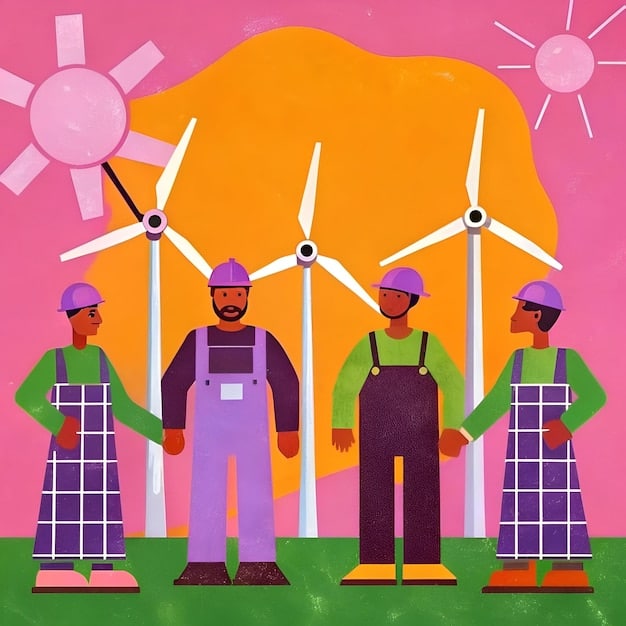US Climate Policy: Effectiveness & Future Strategy Analysis

Analysis of existing US climate policies reveals varied efficacy in mitigating climate change, necessitating a re-evaluation of current approaches and the formulation of more robust future strategies to meet environmental goals.
The intricate relationship between the United States and the global challenge of climate change is a topic of paramount importance. Understanding The US and Climate Change: Evaluating the Effectiveness of Current Policies and Future Strategies requires a nuanced look at historical actions, present commitments, and the ambitious path ahead.
Navigating the American Climate Policy Landscape
The United States, as a major economic and industrial power, plays a pivotal role in global climate dynamics. Its policy evolution reflects a complex interplay of scientific consensus, political will, economic pressures, and public opinion. Early steps in climate policy often focused on research and international cooperation, gradually evolving into more structured domestic actions.
The passage of foundational environmental laws such as the Clean Air Act, while not exclusively climate-focused, laid groundwork for future emission controls. Subsequent administrations adopted varying stances, from active participation in international accords like the Kyoto Protocol to significant withdrawals and re-engagements. This stop-and-go approach has shaped the current policy patchwork. Understanding this historical context is crucial for evaluating the effectiveness of present and future strategies. The sheer scale of the US economy means even incremental changes can have global ramifications.
Key Legislative Frameworks
Several key legislative frameworks underpin the US approach to climate change. These policies often target specific sectors or types of emissions, aiming for incremental progress rather than a single, overarching solution from the outset.
- Clean Air Act (CAA): While primarily for air quality, the CAA has been instrumental in regulating greenhouse gases as pollutants. Its broad authority allows for the control of emissions from power plants and vehicles.
- Energy Policy Act: This act promotes various forms of energy efficiency and renewable energy production through tax incentives and research funding.
- Inflation Reduction Act (IRA): A landmark piece of recent legislation, the IRA represents the largest climate investment in US history, aiming to accelerate the transition to clean energy through substantial tax credits and incentives.
These policies represent diverse tools in the federal government’s arsenal. Their implementation often involves complex regulatory processes and significant inter-agency coordination. The decentralized nature of American governance also means that states and even individual cities play a considerable role in shaping climate action. This layered approach creates both opportunities for innovation and challenges in achieving uniform progress across the nation.
Evaluating the Efficacy of Existing Policies
Assessing the effectiveness of US climate policies is not straightforward. Data on emissions reductions, growth in renewable energy sectors, and public health improvements offer some metrics. However, attributing specific outcomes solely to policy interventions while accounting for economic cycles, technological advancements, and natural variability poses a significant challenge.
For instance, the decline in coal consumption in the US is partly due to regulations but also heavily influenced by the competitive pricing of natural gas and the decreasing cost of renewables. Similarly, while electric vehicle sales are rising, it’s a combination of federal incentives, state mandates, and shifting consumer preferences. This complexity means that even successful policies may have unintended consequences or synergistic effects with other market forces. Public engagement and industry buy-in are also critical factors influencing policy effectiveness. Without broad support, even well-intentioned policies can struggle to achieve their objectives.
Successes and Shortcomings
Despite the challenges, a closer look reveals areas where US policies have made discernible progress and areas where they have fallen short.
- Renewable Energy Deployment: Policies like tax credits and grants have significantly boosted solar and wind power generation, making the US a global leader in some renewable energy technologies.
- Vehicle Emission Standards: Stronger fuel efficiency standards have led to more efficient car fleets, reducing transportation sector emissions.
- Carbon Sequestration Research: Federal funding has advanced research into carbon capture, utilization, and storage (CCUS) technologies, though large-scale commercial deployment remains elusive.
However, several shortcomings persist. The US has struggled to implement a comprehensive national carbon pricing mechanism, a policy widely advocated by economists as an efficient way to reduce emissions. Intermittent changes in political leadership often lead to policy reversals, creating uncertainty for industries and hindering long-term investment in climate solutions. Furthermore, disproportionate impacts on disadvantaged communities from climate change and climate policies highlight the need for more equitable approaches. The scale of the climate crisis demands accelerating policy implementation and overcoming political impasses.
The Inflation Reduction Act: A Game Changer?
The Inflation Reduction Act (IRA) of 2022 represents a significant departure from previous US climate policy approaches, largely due to its scale and long-term investment horizon. It allocates hundreds of billions of dollars towards clean energy, climate resilience, and reduced prescription drug costs, embedding climate action within a broader economic framework. The IRA’s focus on tax credits and grants aims to stimulate private sector investment rather than relying solely on direct regulation.
This market-based approach seeks to make clean energy more competitive than fossil fuels, driving innovation and job creation. Early indicators suggest a surge in clean energy manufacturing announcements and project developments across the country. The long duration of many of its incentives (up to 10 years) provides greater certainty for businesses, encouraging substantial capital deployment. However, its effectiveness will ultimately depend on successful implementation, the response of various industries, and continued political support. The IRA also highlights the growing economic opportunities associated with climate action, shifting the narrative from a cost burden to an investment strategy.
Impacts and Projections
The IRA’s projected impacts are substantial, with analyses suggesting it could significantly accelerate US emissions reductions.
- Emissions Reductions: Projections indicate the IRA could help the US achieve a 40% reduction in emissions below 2005 levels by 2030, a considerable step towards its international climate commitments.
- Job Creation: The clean energy investments are expected to create hundreds of thousands of new jobs in manufacturing, construction, and related sectors.
- Energy Security: By diversifying the energy mix and reducing reliance on fossil fuels, the act aims to enhance US energy independence and security.
Beyond these quantitative measures, the IRA signals a renewed commitment by the US to climate action, potentially influencing international climate negotiations and encouraging other nations to accelerate their own transitions. The “Buy American” provisions within the act also aim to foster domestic supply chains for clean technologies, creating a more resilient and self-sufficient green economy. However, critics point to potential challenges in scaling up nascent technologies, ensuring equitable distribution of benefits, and managing potential supply chain bottlenecks. The journey to a fully decarbonized economy will still require continuous innovation and adaptive policy measures.

Future Strategies: Pathways to Decarbonization
Looking to the future, the US faces the monumental task of achieving net-zero emissions by mid-century, as outlined in its long-term climate strategy. This ambitious goal requires not only sustaining current momentum but also dramatically scaling up efforts across all sectors of the economy. Future strategies will need to address hard-to-abate sectors like heavy industry, aviation, and agriculture, which present unique decarbonization challenges.
Innovation in areas such as advanced battery storage, green hydrogen production, sustainable aviation fuels, and direct air capture technologies will be paramount. Moreover, a comprehensive future strategy must integrate climate resilience into infrastructure planning, adapt to the inevitable impacts of climate change, and ensure a just transition that protects workers and communities dependent on fossil fuel industries. This holistic approach recognizes that climate change is not merely an environmental problem but a profound economic and social challenge requiring systemic transformation. The policy landscape will need to remain flexible, adapting to new scientific understanding and technological breakthroughs.
Key Pillars of Future Climate Action
Several key pillars are expected to form the bedrock of future US climate action, building on existing successes and addressing persistent gaps.
- Cross-Sectoral Electrification: Shifting away from fossil fuels in transportation, buildings, and industry through widespread electrification powered by renewable sources.
- Grid Modernization: Investing in a smart, resilient, and interconnected national grid capable of handling increasing amounts of intermittent renewable energy.
- Carbon Removal Technologies: Developing and deploying technologies that remove carbon dioxide directly from the atmosphere, complementing emissions reductions.
- Nature-Based Solutions: Protecting and restoring ecosystems to enhance carbon sequestration through forests, wetlands, and agricultural lands.
- International Collaboration: Reaffirming and strengthening global partnerships to foster collective action and share best practices in climate mitigation and adaptation.
Beyond these technological and policy interventions, future strategies will also need to address the human dimension. This includes fostering public awareness and education, promoting behavioral changes, and ensuring that climate policies are designed and implemented in an inclusive and equitable manner. The success of future strategies will hinge on sustained political commitment, robust scientific guidance, and broad stakeholder engagement.
Addressing Challenges and Fostering Resilience
The path to a decarbonized and climate-resilient future is fraught with challenges. Political polarization, economic dislocations, and the sheer scale of the required transformation represent significant hurdles. Overcoming these challenges will require navigating complex trade-offs, fostering bipartisan cooperation, and building public consensus.
For instance, the transition away from fossil fuels, while necessary, must be managed carefully to avoid job losses and economic hardship in traditional energy-producing regions. Policies related to workforce retraining, community investment, and federal assistance can facilitate a just transition. Furthermore, the US must simultaneously build resilience against the increasing frequency and intensity of extreme weather events. This involves investing in resilient infrastructure, improving early warning systems, and developing adaptation strategies for vulnerable communities. The interconnectedness of climate, economic, and social systems means that solutions must be integrated and forward-looking.
Building a Climate-Resilient Nation
Building a climate-resilient nation involves multiple layers of planning and investment, from national strategies to local initiatives.
- Infrastructure Hardening: Upgrading critical infrastructure like power grids, transportation networks, and water systems to withstand climate impacts.
- Early Warning Systems: Enhancing capabilities to predict and prepare for extreme weather events such as floods, heatwaves, and wildfires.
- Coastal Protection: Implementing measures like natural defenses (mangroves, wetlands) and engineered solutions (seawalls) to protect coastal communities from sea-level rise and storm surges.
- Water Management: Developing strategies for sustainable water use, addressing drought, and managing flood risks in a changing climate.
- Health and Equity: Prioritizing public health interventions and ensuring that adaptation measures address the disproportionate impacts on disadvantaged populations.
These efforts require significant financial investment and coordinated action across federal, state, and local governments, as well as the private sector. Engaging communities in the planning process is crucial to ensure that adaptation measures are tailored to local needs and priorities. The ongoing learning process, informed by scientific research and real-world experience, will be essential for continuous improvement in climate resilience efforts.

The Role of International Cooperation
The global nature of climate change necessitates robust international cooperation, and the US plays a crucial role in shaping multilateral climate action. Re-engagement with international agreements and forums like the Paris Agreement and the UN Climate Change Conferences (COPs) has been a significant step. The US can leverage its diplomatic influence, scientific expertise, and financial resources to encourage ambition among other major emitters.
Providing financial and technical assistance to developing nations for both mitigation and adaptation is also critical, fulfilling commitments under the Paris Agreement. Shared scientific research, technology transfer, and joint initiatives on climate solutions can accelerate global progress. Furthermore, addressing climate change often intersects with other foreign policy objectives, such as energy security, economic development, and global stability. A coherent international climate strategy positions the US as a leader and a responsible global actor, recognizing that domestic efforts alone are insufficient to solve a problem without borders.
Strengthening Global Climate Partnerships
Strengthening global climate partnerships extends beyond formal agreements to encompass a range of collaborative efforts.
- Multilateral Diplomac: Active participation in UN climate negotiations and other international forums to drive consensus and higher ambition.
- Bilateral Engagements: Forming direct partnerships with key countries, including major emitters, to exchange best practices and coordinate climate action.
- Climate Finance: Contributing to international funds and mechanisms that support climate action in developing countries, particularly for adaptation and clean energy transitions.
- Technology Transfer: Facilitating the sharing of clean energy technologies and expertise, especially with nations that lack the resources for their independent development.
- Climate Science Collaboration: Joint research initiatives to improve understanding of climate change, its impacts, and potential solutions across different regions.
These efforts are vital for building trust, fostering collective responsibility, and ensuring that the global response to climate change is comprehensive and equitable. The US can lead by example through its domestic policies and by advocating for strong, science-based targets and transparent reporting mechanisms internationally. The interconnectedness of the global economy means that climate action overseas directly benefits the US by reducing overall climate risks.
| Key Point | Brief Description |
|---|---|
| 💡 Policy Evolution | US climate policy has shifted from early environmental acts to targeted emission controls and massive investments. |
| 📈 IRA Impact | The Inflation Reduction Act is a game-changer, projecting significant emissions cuts and clean energy growth. |
| 🌍 Future Decarbonization | Future strategies aim for net-zero, focusing on electrification, carbon removal, and cross-sector solutions. |
| 🤝 Global Role | International cooperation is key, with the US leveraging diplomacy and finance to foster global climate action. |
Frequently asked questions about US climate policies
▼
The primary goal of US climate policy is to reduce greenhouse gas emissions significantly to mitigate climate change impacts and achieve net-zero emissions by mid-century. This involves transitioning to clean energy sources, enhancing energy efficiency, and fostering climate resilience across various sectors of the economy.
▼
The IRA significantly boosts US climate efforts by providing unprecedented investments and tax credits for clean energy, electric vehicles, and energy efficiency. It aims to accelerate emissions reductions, create green jobs, and enhance domestic clean technology manufacturing, marking the largest climate investment in US history.
▼
Major challenges include political polarization, potential economic dislocations in fossil fuel-dependent regions, the vast scale of required infrastructure changes, and ensuring equitable impacts across diverse communities. Policy reversals with changes in administration also create uncertainty and hinder long-term planning.
▼
The US contributes through re-engagement with the Paris Agreement, active participation in international climate negotiations, and providing financial and technical assistance to developing nations. It also engages in bilateral partnerships and scientific collaboration to share expertise and accelerate global climate solutions.
▼
Hard-to-abate sectors are those where emissions are difficult to reduce with current technologies, such as heavy industry (steel, cement), long-haul transportation (aviation, shipping), and agriculture. Decarbonizing these sectors requires significant innovation in areas like green hydrogen, sustainable fuels, and advanced carbon capture technologies.
Conclusion
The journey of the United States in addressing climate change is one of evolving policy, significant investment, and persistent challenges. From foundational environmental laws to the transformative Inflation Reduction Act, the nation has progressively built a framework for climate action. While past policies have shown varied effectiveness, the current trajectory suggests a renewed commitment to ambitious decarbonization goals. Future strategies, focusing on comprehensive electrification, climate resilience, and robust international cooperation, are essential for achieving net-zero emissions and safeguarding the nation against increasingly severe climate impacts. The ongoing success of these endeavors hinges on sustained political will, technological innovation, and an inclusive approach that ensures a just and equitable transition for all Americans.





